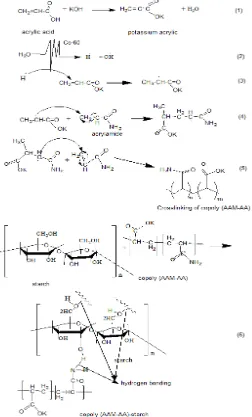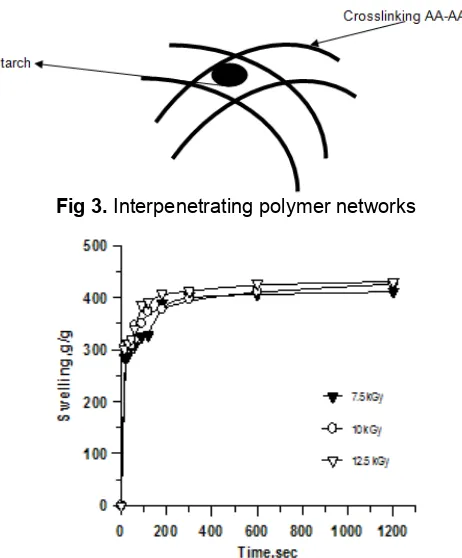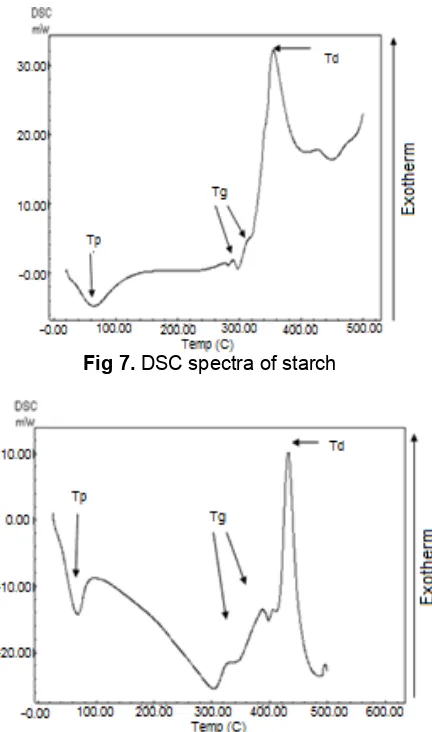FAST SWELLING SUPERABSORBENT HYDROGELS STARCH BASED
PREPARED BY GAMMA RADIATION TECHNIQUES
Erizal
1,*, Dian Pribadi Perkasa
1, Basril Abbas
1, Sudirman
2, and Sulistioso G.S.
2 1Centre for the Application Isotopes and Radiation, National Nuclear Energy Agency, Jakarta 12070, Indonesia
2
Centre for Science and Technology of Advanced Material, National Nuclear Energy Agency, Serpong 15314, Tangerang, Indonesia
Received May 21, 2014; Accepted July 25, 2014
ABSTRACT
Fast swelling hydrogels were synthesized from the mixture of acrylamide (AAM)-acrylic acid (AA)-starch (15:5:1 w/v) solution by radiation crosslinking with varying irradiation doses (7.5-12.5 kGy) at room temperature. The copolymers were characterizated by Fourier transform infra red spectroscopy (FTIR) and Differential scanning calorimetry (DSC). It was found that hydrogels showed superabsorbent properties with higher swelling capacities (~400 g/g) and reached at a very short time (3 min). There was no significance difference between the effect irradiation dose on swelling of hydrogels. The hydrogels were also found sensitive to the ionic strength of medium. The FTIR spectra and thermogram DSC of hydrogels were confirmed the crosslinking occurs in the hydrogels.
Keywords:radiation; superabsorbent; acrylamide; acrylic acid; starch
ABSTRAK
Hidrogel dengan kemampuan swelling yang relatif cepat disintesis dari campuran larutan akrilamida (AAM)-asam akrilat (AA)-pati (15:5:1) menggunakan iradiasi gamma pada beragam dosis iradiasi (7,5-12,5 kGy). Kopolimer dikarakterisasi menggunakan Fourier Transform infra red (FTIR) dan Differential scanning calorimetry (DSC). Hasil penelitian menunjukkan bahwa hidrogel bersifat superabsorben dengan kemampuan swelling yang relatif tinggi (~400 g/g) dicapai dalam waktu singkat (3 menit). Tidak terlihat perbedaan yang signifikan pada pengaruh dosis iradiasi terhadap swelling hidrogel. Hidrogel peka terhadap kekuatan ionik media uji. Spektrum FTIR dan termogram DSC mengkonfirmasi terjadinya ikatan silang pada hidrogel.
Kata Kunci:radiasi; superabsorben; akrilamida; asam akrilat; pati
INTRODUCTION
Nowadays, the need to the materials that have good performance in absorbing a large amount quantity of water or liquid has very interesting objects for researchers. One of the such materials is the synthetic hydrogel matrices which comprise water insoluble, but water swellable crosslinked hydrophilic polymers. These materials are known as hydrogel superabsorbent (HSA), originated in the United states as water retention agents in agriculture, and developed in Japan in middle 1970’s in the personal care and hygienic products such as surgical pads, hot and cold therapy packs, medical waste solidification, disposable diapers, sanitary napkins etc. [1]. Moreover, they are used as artificial soils for hydrophonics in soil conditioning, as drug delivery systems agents for pharmaceuticals or agrochemicals and the numerous applications [2-5].
In recent years research on HSA have been intensively focused on some types of basic materials such as acrylic acid (AA) and acrylamide (AAM) monomers and its copolymers [6-8]. However, the disadvantage of HSA based on monomers/polymers synthetic is not biodegradable which will cause environmental problems. Hence, the development of multi-component superabsorbent derived from natural polymer and eco-friendly additives is subject of great interest due to their unique commercial and environment advantages and such materials have also been honored as the material families of “in greening the 21stcentury materials world” [9].
physical gels under specific conditions. Using starch-based hydrogels has some advantages such as it has a high swelling capacity in water, applicable to a variety of process, available in many countries, abundant natural biopolymer, and easy to prepare with fairly inexpensive reagents. Therefore, It is expected that the new of HSA with improve structure and performance can be developed by the effective combination of AAM-AA with starch via gamma irradiation technique.
In previous work, the swelling behavior of poly(AAM-AA)-starch hydrogels containing 5% AAm, 15% acrylic acid with varying starch concentration (1-3%) synthesized by gamma radiation at different doses (10-30 kGy) were studied [10]. We found that incorporation of 1% starch content present in hydrogel irradiated at a dose 10 kGy, the maximum swelling ratio of hydrogel in the granular form was 350 g/g and reached at 24 h. For the application, especially as absorbents incorporated in the baby napkins, this HSA is not applicable because its swelling rate is a low. Following our previous works, we have recently emphasized mostly on the swelling rate enhancement through reducing irradiation dose. In addition, formation of powder form in the final products provides a certain way to improve swelling rate of hydrogels.
In the present work, a series hydrogel superabsorbent of poly(AAM-AA)-starch containing 5% AAM, 15% AA with 1% starch were irradiated using gamma radiation at a low radiation range of dose 7.5-12.5 kGy (dose rate 7.5 kGy/h). Effect different irradiation doses on swelling ratio were investigated. The possibility applications of copoly(AAM-AA)-starch HSA in health care is an important aim of this work.
EXPERIMENTAL SECTION
Materials
Cassava starch was obtained from local Industry. Acrylic acid (AA) and acrylamide (AAM) were purchased from E. Merck. All the other reagents were of analytical grade and used without further purification. Distilled water was used for the synthesis of the hydrogels.
Instrumentation
FTIR spectrophotometer, Shimadzu, Prestige-21. Differential scanning calometry (DSC), Shimadzu, DSC 60.
Procedure
Preparation of poly (Acrylamide-co-Acrylic Acid)-starch hydrogels
One gram of starch powder was mixed with 50 mL distilled water, stirred at 200 rpm at approximately
85±3 °C for 1 h to form a paste-like slurry. Furthermore, the gelatinized starch was cooled at room temperature. Into the viscous solution was poured 15 mL acrylic acid which has been neutralized and 5 g of acrylamide, the volume of the mixture was made up to 100 mL with distilled water. The mixture was stirred at 200 rpm at room temperature for 30 min. The gelatinized starch-monomer mixture was transferred into 30 cm3a plastic
bag, sealed, and then irradiated by γ-radiation from a
60
Co source (dose rate 7.5 kGy/h) with the doses of 7.5 kGy; 10 kGy; and 12.5 kGy at room temperature. The hydrogels obtained were vacuum dried at 60 °C till constant weight and then milled to averages 60-80 mesh.
Gel fraction determination
The hydrogel powder were taken in a 300 mesh of tea bags and extracted with distilled water for 24 h to remove the soluble fraction. The gels were dried to constant weight under vacuum at 60 °C to determine the soluble fraction in the samples gravimetrically
Gel fraction (%) =W W xg o 100 (1)
whereWgis the weight of dry gels after extraction and
Wo is the initial weight of the gel.
Swelling rate studies
The swelling rates of hydrogels were determined by gravimetric method. The dried gel samples (Wo) were immersed in 50 mL distilled water (and other test solutions) and dispersed with magnetic stirring at 200 rpm at room temperature. The swollen sample was filtered at desired time through weighed mesh wire gauze (sieve). The excess water was removed by hanging the sieve for 1 h till no water was dropped off. Then water absorbed by hydrogels were weighed (Wt). The swelling ratio was calculated as
Swelling ration = W Wt o WO (2)
where Wtis the weight of the swollen gel at time t and Wo is the initial weight of the dried gels.
FT-IR characterization
The poly(AA) hydrogel, poly( AAM-co-AA)-starch and pure starch were mixed with solid KBr in stainless steel sample cup and recorded with DRS system, respectively. A spectrum for each sample was obtained using Shimadzu IR Prestige-21 spectrometer model 800 series from 4000 to 400 cm-1 with scan speed 20 cm-1 and all spectra were displayed in multipoint base line correction.
Thermal analysis
Fig 1. Effects of irradiation dose on gel fraction of superabsorbent hydrogel poly (AAm-co-AA)-starch containing 5% AAM, 15% AA, 1% starch sealed in an aluminium pan and heated from room temperature to 600 °C at a heating rate of 10 °C/min.
Fig 2. The schematic possibility mechanism reaction
occurred in radiation processing of the mixture of AA-AAM-starch
RESULT AND DISCUSSION
Gel Fraction
The effect of different irradiation dose on the gel fraction of poly(AA-AAM)-starch is presented in Fig 1. It can be seen that with increasing irradiation dose from 7.5 to 12.5 kGy, the gel fraction of hydrogels increase from 75% to 90%. It is known that starch is a natural polysaccharide, which degrades on irradiation like the common natural polymers by breakdown of the main chains [11], while the mixture of AAm and AA crosslink in aqueous medium by irradiation. When the mixture containing starch, AAm and AA is irradiated an interpenetrating polymer network (IPN) is formed with the chemical crosslinking of poly(AAm-co-AA) and physical crosslinking of starch. As a result with increasing irradiation dose up to 12.5 kGy, the density crosslinking of hydrogels increase and the gel fraction of increase.
Fig 3.Interpenetrating polymer networks
Fig 4. Swelling kinetics poly (AAm-co-AA)-starch superabsorbent hydrogels. with the composition of 5:15; 1 (% Wt) radiated at irradiation dose 7.5; 10; and 12.5 kGy
Fig 5.Dynamic swelling curve of the poly
(AAM-co-AA)-starch superabsorbent hydrogels with different irradiation doses in 0.09% NaCl and water
with the starch molecule (reaction 6) through hydrogen bond.
Besides, there is another possibility of irradiated product of the AA-AAM-starch mixture is that the starch will be entrapped in poly (AA-co-AAM) matrices as IPN (Interpenetrating Polymer Networks) as final product is shown as Fig. 3.
In addition, some soluble components in water resulting from irradiation such as peroxides, degradation products of starch, acrylic acid and potassium acrylate causing the gel fraction of the poly (AA-AAM)/starch hydrogel can not be achieved to 100%.
Effect of Immersing of Time on the Swelling of Hydrogel
The effect of immersing of time on swelling kinetics of copoly (AAM-AA)-starch hydrogels in water is presented in Fig 4. In the initial state at 15 sec, the sweling ratio of hydrogels is relatively large attained 300 times of its dried weight. With the increase of immersing of time up to 200 sec (~3 min), the swelling ratio of hydrogels gradually increased up to 400 g/g. Further increasing of immersing of time up to 1200 sec, the water absorption of hydrogels is relatively constant in the range of swelling ratio 400-420 g/g. In addition, no significant change on swelling ratio as irradiation dose increased from 7.5 kGy to 12.5 kGy. It is strongly suspected as the optimum dose range for the relatively large of the rate of absorption of hydrogels in this study. This is confirmed by our previous studies with increasing irradiation dose above 15 kGy caused the rate of absorption of the hydrogel decreased [10]. This is due to increasing irradiation doses, the density of crosslinked hydrogels increase and decreasing the rate of water absorption.
The starchs are known as cellulose derivate compounds consisting of hydroxyl group (OH) along their polymer backbones which acts as hydrophilic sites. In addition, the acrylic acid containing carboxylic groups (COOH) as hydrophilic groups is easily binding with water molecules to form hydrogen bonds with water. Some researchers reported that acrylic acid-based superabsorbent hydrogel absorbs large amount of water with the rate swelling in the range of minutes, hours and days [10,12-14]. Hence, it is indicated that the combination of starch with AAM-AA in the powder form of hydrogel prepared at a low irradiation dose (7.5 kGy) when compared with granular form (previous work) were greatly improved the capacity of hydrogels to absorb water.
Swelling of Hydrogels in Saline Solution
Fig 6.FTIR spectra of superabsorbent hydrogel poly(AAM-co-AA)-starch at different irradiation doses of a) 7.5 kGy, b) 10kGy, c) 12.5 kGy, and d) starch
Table 1.Gelatinization temperature (Tg) and decomposition (Td) temperature of starch and poly(AAM-co-AA)-starch
hydrogels prepared by gamma irradiation with different irradiation doses
AA-AAM-starch superabsorbent in water and 0.09% NaCl solutions are shown in Fig. 5.
In water, the swelling ratios increased with prolong immersing time. The superabsorbent reached swelling equilibrium ~400 within 600 sec. Further increase of immersing time did not influence of swelling ratio of the superabsorbent. However, a distinct swelling was observed in NaCl solution. The swelling of superabsorbent increased gradually from 92 to 175 g/g of equilibrium state at 600 sec. Thus, the swelling ratio of superabsorbent in saline solution is low compared with swelling in water. The behavior can be explained on the basis of osmotic pressure developed due to unequal distribution of ions in the medium and the polymer network. The ions attached to the polymer network are
immobilized and considered to be separated from the external solution by a semipermeable membrane. When the hydrogels are placed in water, there is maximum swelling. When the polymer is in NaCl solution the osmotic pressure developed is much lower because the external solution contains Na+and Cl
-FTIR Analysis
Fig 7.DSC spectra of starch
Fig 8. DSC spectra of poly(AAM-co-AA)-starch (7.5
kGy)
Fig 9.DSC spectra of poly(AAM-co-AA)-starch (10 kGy)
Fig 10. DSC spectra of poly(AAM-co-AA)-starch (12.5
kGy)
dose 7.5 kGy (curve 4a), the peaks observed at 3666 cm-1, corresponding to the carboxylic acid groups from AA, hydroxyl from starch and the NH stretching of acrylamide units 15]. The absorbance at 2926 cm-1 is assigned to –C-H stretching of all polymers, and the absorbance at 1489 cm-1 is assigned to the –COOK group [24]. A weak band at 2926 cm-1 is indicated the presence of C-H stretch and a characteristic peak at 1731 cm-1is attributed to tightly bound water present in the starch. The absorption at 1029 cm-1is typical of the
system (C-O-C), skeletal mode vibration of
α-1,4-glycosidic linkage and the peaks at 1489, 1193 and 1029 cm-1were assigned as the peaks contributed from starch [16]. In comparison of curve a (7.5 kGy) against the curve b (10 kGy) and curve c (12.5 kGy), it can be seen that the peaks at 1489, 1193, and 889 cm-1 (curve a) were shifted to higher wave numbers with the broadening peaks. The spectra starch is presented in Fig. 4d, the wide bands observed at 3485 cm-1 can be attributed to the O-H stretching of the amylopectin and its width were ascribed to the formation of inter and
intramolecular hydrogen bonds. The bands at 2927 cm -1
was attributed to the asymmetric stretching of C-H, while the bands at 1635 cm-1ascribed to the basorbed water and the bands 1456 cm-1and at 1336 cm-1to the angular deformation of C-H. The C-O ether bond shows stretching at 1153 cm-1 while the C-O alcohol bond shows stretching at 997 cm-1. This is indicated that the starch entrapped in the poly(AA-co-AAM) matrices by crosslinking or grafting with increasing irradiation dose.
DSC Measurements
temperature (Tp), two glass transition temperature and one exothermic peak at 354.83 °C is decomposition temperature of the starch in the cassava [17]. Structural relationships between the amorphous regions and crystallites within the starch granule are responsible for the sharpness of the transition and the temperature at which it occurs [18]. Fig. 8 shows the thermogram of poly(AAM-co-AA) starch prepared at irradiation dose of 7.5 kGy with endotherm gelatinization peak at 66.23 °C. In addition to this a broad exotherm decomposition peak was obtained at 408.39 °C showing the crystallinity of hydrogel in different form. Fig. 9 shows the thermogram of poly(AAM-co-AA) starch prepared at irradiation dose of 10 kGy with endotherm gelatinization peak at 66.23 °C and two endotherm glass transition peak at 349.40 °C and 387.90 °C, respectively. There is one a single sharp exothermic peak at 423.82 °C, which indicated homogeneity of the crystallinity of hydrogel. Fig. 10 shows the thermogram of poly(AAM-co-AA) starch prepared at irradiation dose of 12.5 kGy with endotherm gelatinization peak at 65.02 °C and two endotherm glass transition peak at 349.72 °C and 402.78 °C, respectively. There was one a sharp exothermic peak at 437.22 °C due to the decomposition of hydrogel with the homogenous crystalline structure. However, it can be concluded that with increasing irradiation doses from 7.5 kGy to 12.5 kGy the decomposition temperature of hydrogels increase from 408.39 °C to 437.22 °C because of the crosslinking, which will disturbs the intra and inter molecular hydrogen bonds of starch.
CONCLUSION
A superabsorbent of poly(AAM-co-AA)-starch was synthesized by radiation copolymerization reaction of AAM, AA and starch in aqueous solution at varying irradiation doses (7.5 kGy-12.5 kGy). Experimental results show that the hydrogels can absorb water (swelling) very fast with swelling ratio was higher (~400 g/g) attained at 3 min. There was no significant different on swelling ratio among irradiation doses of hydrogels. Due to ionic strength, the swelling ratio of poly (AAM-co-AA)-starch hydrogel was low compared to its swelling in water. From FT-IR and DSC measurement, it was shown that the crosslinking occurs in the hydrogels.
ACKNOWLEDGEMENT
The authors are grateful to all staff at IRKA Irradiator facility that are very helpful for samples irradiation.
REFERENCES
1. Bucholz, F.L., Graham, T., 1998, Modern Superabsorbent Polymer Technology, Wiley VCH, New York, p.151.
2. Abd Rehim, H.A., Hegazy, E.S.A, and Abd El-Mohdy, H.L., 2004, J. Appl. Polym. Sci., 93 (3), 1360–1371.
3. Bakass, M., Mokhlisse, A., and Lallemant, M., 2002,J. Appl. Polym. Sci., 83 (2), 234–243.
4. Chang, C., Duan, B., Cai, J., and Zhang, L., 2010,
Eur. Polym. J., 46 (1), 92–100.
5. Flores, J.G., Herraiz, M., and Ruiz del Castillo, M.L., 2006,J. Sep. Sci., 2006, 29 (17) 2677–2683. 6. Tomar, R.S., Gupta, I., Singhai, R., and Nagpal,
A.K., 2007,Des. Monomers Polym., 10 (1), 49–66. 7. Erizal, 2010,Sci. J. Appl. Isot. Radiat., 6 (2), 105–
116.
8. Şolpan, D., Duran, S., Saraydin, D., and Guven,
O., 2003,Radiat. Phys. Chem., 66 (2), 117–127. 9. Kurita, K., 2001, Prog. Polym. Sci., 26 (9), 1921–
1971.
10. Erizal, 2012,Indo. J. Chem., 12 (2), 113–118. 11. Charlesby, A., Atomic Radiation and Polymers,
1960,Pergamon Press, Oxford.
12. Defader, N.C., Ganguli, S., Sattar, M.A., Haque, M.E., and Akhtar, F., 2009,Malaysian Polym. J., 4 (2), 37–45.
13. Khoylou, F., and Naimian, F., 2009, Radiat. Phys. Chem., 78 (3), 195–198.
14. Francis, S., Kumar, M., and Varshney, L., 2004,
Radiat. Phys. Chem., 69 (6), 481–486.
15. Elvira, C., Mano, J.F., Román, J.S., and Reis, R.L., 2002,Biomaterials, 23 (9), 1955–1966.
16. Fang, J.M., Fowler, P.A., Tomkinson, J., and Hill, C.A.S., 2002,Carbohydr. Polym.,47 (3), 245–252. 17. Colette, F.Q., 2011,Water LLC, TA Instrument, 1–
11.



